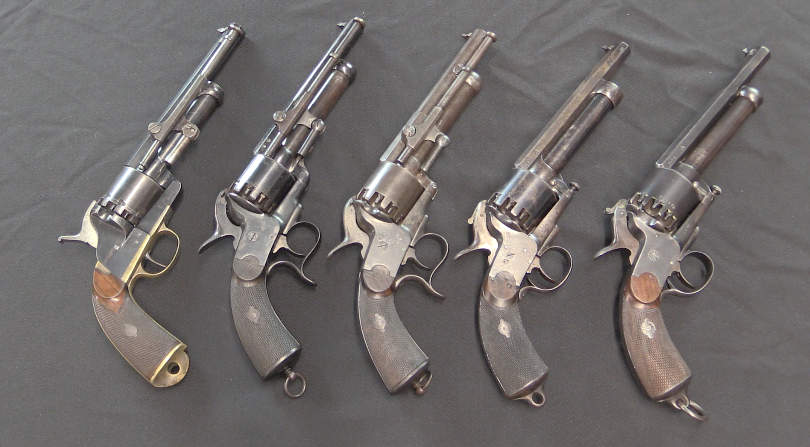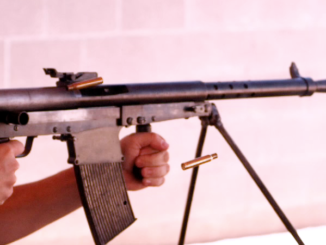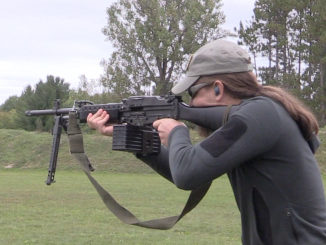When John Browning developed the self-loading shotgun that would become the Auto-5, he decided to depart from his existing standard business relationship with the Winchester company. Browning had historically sold his patents to Winchester for a flat fee, but with his new shotgun he decided he wanted a royalty per gun sold instead. Winchester thought about it and decided that perhaps Browning was not quite as important as he though he was, and they rejected his request. So Browning instead took the design to Fabrique Nationale in Belgium, who was happy to offer him a royalty.
The design became a tremendous success, and it left Winchester in a bit of a pickle. They had been planning on marketing a self-loading shotgun, but now the didn’t have the rights to one. So what they did was to purchase one of the very first FN guns made (serial number 262) and use it to figure out a loophole around Browning’s patent. The most significant feature was the bolt handle, which unlocked the action and allowed the bolt to be opened without the barrel reciprocating (this was a long-recoil action). Winchester ended up using the very simple method of adding some texturing to the barrel and requiring the user to simply cycle the barrel back all the way to open the action. Needless to say, this was substantially inferior to the way one could operate the Browning Auto-5, and it was a factor in the Winchester design (the Model 1911, not to be confused with the 1911 pistol) garnering the nickname “Widowmaker”. But that’s a story for another episode…
Thanks to the Cody Firearms Museum for allowing me access to film this very cool prototype shotgun! Check them out here:
https://centerofthewest.org/explore/firearms/




My cousin and I were reminiscing recently about an escapade w/ his 20 ga Auto 5 – the magazine cutoff saved Grandma’s tv. Much drama averted.
there must have been much gnashing of teeth at Winchester, when they realized what they had done. a huge management blunder.
“(…)they realized what they had done(…)”
This must take several years, as in 1940 they launched production of very similar fire-arm named Winchester Model 40 https://guns.fandom.com/wiki/Winchester_Model_40
It managed to sell even worse than Model 1911.
Before the plunger operated blowback 1910, 1907, and 1905 was the 1903 Winchester in .22 Winchester Automatic. The 1903 and the follow-on Model 63 are great little guns, even 100+ years later. The centerfire 1905, 1907, and especially the .401 1910, not so much, particularly when it comes to holding the bolt open.
The infamous Wichester widow maker shotgun. Or how to evade a patent by making the gun unsafe to handle, at least for careless shooters.
I have heard this about this shotgun all my life: “widow-maker”, “suicide special”, etc, but I have never figured out how it is so dangerous to one’s self. I handled one at a gun shop many years ago and it seemed intuitive to operate it like a pump gun – shoulder the gun, grab the barrel & pump it. I assume people were putting the butt on the ground and holding the barrel like you’d churn butter and pump it while looking down the muzzle. But since guns don’t just go off by themselves, were these people steadying the gun with a toe in the trigger guard? Is there some design flaw that if the barrel isn’t pumped enough or too much it fires? Either way, if you’re staring down the muzzle while operating the action of any firearm you deserve your Darwin award…
If it was as dangerous as touted then this should result in lawsuit being launched at Winchester. Did that happen? If yes what was outcome?
I doubt there were any product-liability lawsuits, but Winchester instructed its dealers to take back Model 11s with no questions asked, and either refund the purchase price or swap the guns for a Model 12 or 97.
The basic design failings of the Model 11 were its lack of a bolt handle (patented by Browning, of course) which necessitated a different method of cocking it (that knurled area on the barrel), coupled with a very strong recoil spring, and a traditional ‘single-action’ sear and trigger mechanism that was designed for a crisp, light release but also made it sensitive to impact.
Further, old-time shotgun shells were made of paper, which swelled when wet and were prone to damp-caused hangfires.
‘Incautious’ people, or weak-armed people, or short-armed people, did have the habit of resting the butt on the ground and using both hands to shove the stiff-springed barrel back to cock the gun, or to clear a misfired/swollen shell from the chamber. If there was a hangfire, and the muzzle was pointed ‘just so,’ and/or if the frustrated shooter thumped the butt on the ground or really slammed the barrel back hard like a pogo stick to get some energy to help clear the chamber, the shooter could quickly became the shot.
Sure, basic safety precautions would prevent getting one’s face and head shot off, but practically BEGGING a shooter to do something stupid to operate the gun is not wise.
According to lore, the most recent recorded victims of Model 11s were in 2005.
There were other design failings with the gun including rapidly-wearing buffer rings and broken stocks, but those didn’t tend to become fatal flaws.
In the biography by his oldest son (“John M. Browning: American Gunmaker” by John Browning and Curt Gentry) it is stated that the first 10,000 FN-made shotguns were purchased by Browning personally (and paid for with “a huge deposit”) and from Belgium delivered to a wholesale sporting-goods firm in New York City called Schoverling Daly & Gales. Browning had good relations with this firm because they sold his Winchester products. The “Browning Automatic Arms Company” did not in fact exist, and was based in Ogden, Utah, only because Browning was. Browning fils and Gentry say that all these guns were sold by Schoverling and that they sold out in a year. They do not mention JMB selling any guns from his store in Ogden. From this I figure it more likely that Winchester bought this sample gun from a dealer nearer their home in Connecticut. (If the Cody Museum has some paperwork that says otherwise I would like to hear of it.)
Incidentally Browning & Gentry mention that one of the “pilot models” of the A5 fired 40,000 rounds. The book was published in 1964 by the Browning Company and my copy was reprinted in 1987. I recommend it as an adjunct to the book reviewed two days ago.
Widow maker was a term applied to several shotguns including the Winchester 1893 as it was originally built to use B/P cartridges and regularly blew up with Nitro cartridges. The Marlin 1898 also picked up this title.
Why or how they got such a bad reputation is I expect a story unto itself. I have both and my wife is not a widow yet.
BTW, on the subject of Browning prototypes, Ian could well pay a visit to the Browning Museum in Ogden Utah. It is based in the old station complex and sits with the Railway museum, cowboy museum and Art gallery. Because of an insufferable docent at the Browning Museum, I found the rest of the complex of more interest (golden Spike from Promintory Summit included). It undoubtedly holds a treasure trove of guns which deserve more scolarship and better presentation though.
“Widowmaker” is not just that.
I know a man who has three fingers missing on his right hand. Which he lost while trying to remove the stuck cartridge from the wet paper case.
Since the handle of the bolt is too small for such a large force, he did this by jerking the barrel.
In addition, he almost lost his head along with his fingers.
PS It was MTz 21-12, from TOZ.
Interesting fact, despite the shortcomings in 1881, Browning sold his patents to Winchester for a fixed fee of $300,000. Winchester continued to sell guns using his locking system until 1892, when he sold the company and patents to Colt. Winchester retained ownership of the patents until 1902, when he assigned them to the newly formed Remington Arms Company, based in Ilion, New York. After Colt bought the company in 1902, Remington Arms continued to sell pistols with a rotary locking system.